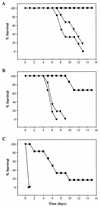Disruption of the Candida albicans TPS1 gene encoding trehalose-6-phosphate synthase impairs formation of hyphae and decreases infectivity
- PMID: 9683476
- PMCID: PMC107363
- DOI: 10.1128/JB.180.15.3809-3815.1998
Disruption of the Candida albicans TPS1 gene encoding trehalose-6-phosphate synthase impairs formation of hyphae and decreases infectivity
Abstract
The TPS1 gene from Candida albicans, which encodes trehalose-6-phosphate synthase, has been cloned by functional complementation of a tps1 mutant from Saccharomyces cerevisiae. In contrast with the wild-type strain, the double tps1/tps1 disruptant did not accumulate trehalose at stationary phase or after heat shock. Growth of the tps1/tps1 disruptant at 30 degreesC was indistinguishable from that of the wild type. However, at 42 degreesC it did not grow on glucose or fructose but grew normally on galactose or glycerol. At 37 degreesC, the yeast-hypha transition in the mutant in glucose-calf serum medium did not occur. During growth at 42 degreesC, the mutant did not form hyphae in galactose or in glycerol. Some of the growth defects observed may be traced to an unbalanced sugar metabolism that reduces the cellular content of ATP. Mice inoculated with 10(6) CFU of the tps1/tps1 mutant did not show visible symptoms of infection 16 days after inoculation, while those similarly inoculated with wild-type cells were dead 12 days after inoculation.
Figures




Similar articles
-
Trehalose hydrolysis is not required for human serum-induced dimorphic transition in Candida albicans: evidence from a tps1/tps1 mutant deficient in trehalose synthesis.Res Microbiol. 1999 Oct;150(8):521-9. doi: 10.1016/s0923-2508(99)00105-9. Res Microbiol. 1999. PMID: 10577485
-
Control of glucose influx into glycolysis and pleiotropic effects studied in different isogenic sets of Saccharomyces cerevisiae mutants in trehalose biosynthesis.Curr Genet. 1995 Jan;27(2):110-22. doi: 10.1007/BF00313424. Curr Genet. 1995. PMID: 7788713
-
The byp1-3 allele of the Saccharomyces cerevisiae GGS1/TPS1 gene and its multi-copy suppressor tRNA(GLN) (CAG): Ggs1/Tps1 protein levels restraining growth on fermentable sugars and trehalose accumulation.Curr Genet. 1994 Oct;26(4):295-301. doi: 10.1007/BF00310492. Curr Genet. 1994. PMID: 7882422
-
Structural and In Vivo Studies on Trehalose-6-Phosphate Synthase from Pathogenic Fungi Provide Insights into Its Catalytic Mechanism, Biological Necessity, and Potential for Novel Antifungal Drug Design.mBio. 2017 Jul 25;8(4):e00643-17. doi: 10.1128/mBio.00643-17. mBio. 2017. PMID: 28743811 Free PMC article.
-
Cloning and characterization of genes encoding trehalose-6-phosphate synthase (TPS1) and trehalose-6-phosphate phosphatase (TPS2) from Zygosaccharomyces rouxii.FEMS Yeast Res. 2003 Jun;3(4):433-40. doi: 10.1016/S1567-1356(03)00035-7. FEMS Yeast Res. 2003. PMID: 12748054
Cited by
-
Relevance of trehalose in pathogenicity: some general rules, yet many exceptions.PLoS Pathog. 2013 Aug;9(8):e1003447. doi: 10.1371/journal.ppat.1003447. Epub 2013 Aug 15. PLoS Pathog. 2013. PMID: 23966851 Free PMC article. No abstract available.
-
Structure-guided approaches to targeting stress responses in human fungal pathogens.J Biol Chem. 2020 Oct 16;295(42):14458-14472. doi: 10.1074/jbc.REV120.013731. Epub 2020 Aug 12. J Biol Chem. 2020. PMID: 32796038 Free PMC article. Review.
-
Structures of trehalose-6-phosphate phosphatase from pathogenic fungi reveal the mechanisms of substrate recognition and catalysis.Proc Natl Acad Sci U S A. 2016 Jun 28;113(26):7148-53. doi: 10.1073/pnas.1601774113. Epub 2016 Jun 15. Proc Natl Acad Sci U S A. 2016. PMID: 27307435 Free PMC article.
-
Genetics of trehalose biosynthesis in desert-derived Aureobasidium melanogenum and role of trehalose in the adaptation of the yeast to extreme environments.Curr Genet. 2018 Apr;64(2):479-491. doi: 10.1007/s00294-017-0762-z. Epub 2017 Oct 10. Curr Genet. 2018. PMID: 29018921
-
Trehalose synthesis and metabolism are required at different stages of plant infection by Magnaporthe grisea.EMBO J. 2003 Jan 15;22(2):225-35. doi: 10.1093/emboj/cdg018. EMBO J. 2003. PMID: 12514128 Free PMC article.
References
-
- Bell W, Klaasen P, Ohnacker M, Boller T, Herweijer M, Schoppink P, van der Zee P, Wiemken A. Characterization of the 56 kDA subunit of yeast trehalose-6-phosphate synthase and cloning of its gene reveal its identity with the product of CIF1, a regulator of carbon catabolite inactivation. Eur J Biochem. 1992;209:951–959. - PubMed
-
- Bergmeyer H U. Methods of enzymatic analysis. Weinheim, Germany: Verlag Chemie; 1983.
-
- Blázquez M A. Un nuevo mecanismo de control de la glicolisis en Saccharomyces cerevisiae: la inhibición de las hexokinasas por trehalosa-6-fosfato. PhD. thesis. Madrid, Spain: Faculty of Sciences, Universidad Autónoma de Madrid; 1995.
-
- Blázquez M A, Gancedo C. Identification of extragenic suppressors of the cif1 mutation in Saccharomyces cerevisiae. Curr Genet. 1994;25:89–94. - PubMed
-
- Blázquez M A, Gancedo C. Mode of action of the qcr9 and cat3 mutations in restoring the ability of Saccharomyces cerevisiae tps1 mutants to grow on glucose. Mol Gen Genet. 1995;249:665–664. - PubMed
Publication types
MeSH terms
Substances
Associated data
- Actions
LinkOut - more resources
Full Text Sources
Other Literature Sources
Molecular Biology Databases

